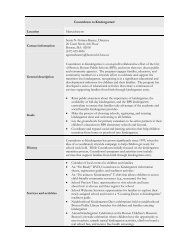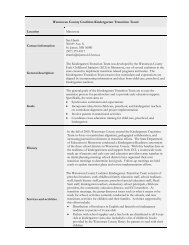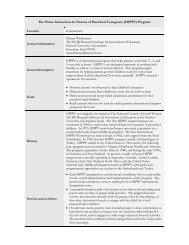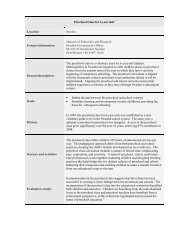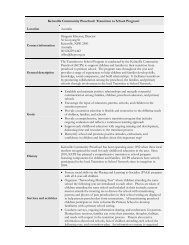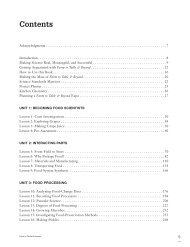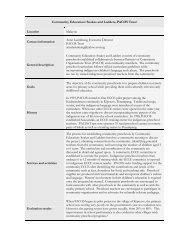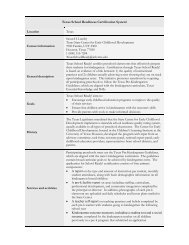Proceedings of the Fourth Annual Teachers College Educational ...
Proceedings of the Fourth Annual Teachers College Educational ...
Proceedings of the Fourth Annual Teachers College Educational ...
Create successful ePaper yourself
Turn your PDF publications into a flip-book with our unique Google optimized e-Paper software.
that children’s photographs were polysemic – “capable <strong>of</strong> generating multiple meanings in <strong>the</strong> viewing<br />
process” (p. 1515). Second, <strong>the</strong>y presented tensions and contrasts between viewers (p. 1516).<br />
Negatives<br />
There were also challenges in using photo elicitation interviews. There was tension between collecting<br />
data and showing compassion towards <strong>the</strong> interviewee (Clark-Ibánez, 2004, p. 1517). Confidentiality <strong>of</strong><br />
<strong>the</strong> interviewee and <strong>the</strong> associated ethical dilemmas are also important (Clark-Ibánez, 2004, p. 1517).<br />
Keeping possession <strong>of</strong> <strong>the</strong> camera and learning skills to shoot photographs properly is something that<br />
does not occur in regular interview situations that do not involve photographs (Clark-Ibánez, 2004, p.<br />
1517).<br />
Methods, techniques, or modes <strong>of</strong> inquiry<br />
The study consists <strong>of</strong> qualitative methods, specifically oral interviews conducted by <strong>the</strong> principal<br />
researcher <strong>of</strong> a 5th grade urban public school class. The method used is a personal photo gallery to elicit<br />
intellectual and affective responses to <strong>the</strong>se images in terms <strong>of</strong> student conceptions <strong>of</strong> <strong>the</strong>ir own national<br />
identities.<br />
Data sources, evidence, objects or materials<br />
In terms <strong>of</strong> data sources, evidence, objects or materials, <strong>the</strong> researcher will utilize a personal photo<br />
gallery to elicit intellectual and affective responses to <strong>the</strong>se images in terms <strong>of</strong> student conceptions <strong>of</strong><br />
<strong>the</strong>ir own national identities. I would like to expand this research into media<br />
production/collection/elicitation where students create <strong>the</strong>ir own photography, videos or utilize found<br />
objects, etc. to help <strong>the</strong>m explore <strong>the</strong>ir national identity.<br />
Results and/or substantiated conclusions or warrants for arguments/point <strong>of</strong> view<br />
Although <strong>the</strong>re was no clear distinction between <strong>the</strong> intellectual and affective domains, it is clear from<br />
student responses that photo elicitation interviews hold promise in assisting educational researchers in<br />
eliciting results that may not normally be provided students from who are younger in age, second<br />
language learners or immigrants from o<strong>the</strong>r nations.<br />
Scientific or scholarly significance <strong>of</strong> <strong>the</strong> study or work<br />
The scholarly significance <strong>of</strong> this work is that studying photo elicitation interview techniques begins to<br />
explore a potentially highly useful way to elicit interview information from students and young people who<br />
may be less capable than older people in terms <strong>of</strong> providing affective and intellectual answers in<br />
interview-type settings. Fur<strong>the</strong>r, with <strong>the</strong> advent <strong>of</strong> low-cost media production techniques, photo elicitation<br />
may be <strong>the</strong> first in <strong>the</strong> digital production field in terms <strong>of</strong> being used within research settings (e.g.<br />
analogous techniques could be employed in video production, audio production, video game<br />
development, online social networking, mobile phone technology, etc.). As a result, <strong>the</strong> lessons learned<br />
from this methodology could provide <strong>the</strong> lingua franca for digital media production elicitation techniques.<br />
References<br />
Clark-Ibánez, M. (2004). Framing <strong>the</strong> social world with photo-elicitation interviews.<br />
American Behavioral Scientist, 47, 1507-1527. DOI: 10.1177/0002764204266236.<br />
http://abs.sagepub.com/cgi/content/abstract/47/12/1507<br />
Collier, Jr., J. (1967). Interviewing with photographs, Chapter 6 in Visual Anthropology:<br />
Photography as a Research Method. New York: Holt, Rinehart.<br />
Harper, D. (2002). Talking about pictures: A case for photo elicitation. Visual Studies, 17(1),<br />
13-26.<br />
Mead, M. & Bateson, G. (1942). Balinese characters. New York: New York Academy <strong>of</strong><br />
Sciences.<br />
Meo, A.I. (2010). Picturing students’ habitus: The advantages and limitations <strong>of</strong> photo-<br />
elicitation interviewing in a qualitative study in <strong>the</strong> city <strong>of</strong> Buenos Aires. International Journal <strong>of</strong><br />
Qualitative Methods, 9(2). 149-171.<br />
Suchar, C.S. (1997). Grounding visual sociology in shooting scripts. Qualitative Sociology,<br />
20(1), 33-55.<br />
68



